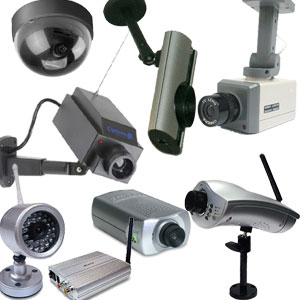Linux video camera Security II
A few months back we have dwelled on using a web camera to augment the security of our premises. We have talked about using the ubiquitous web camera to double up as a security camera. But there are several drawbacks in using a standard web camera for security applications:
It has a limited angle of vision – Originally a web camera is designed to have a 45 degree of view. It comes with a pre focused lens and the lens quality is not enough to provide adequate resolution for security purposes.
Even with a higher resolution web camera which provides 2 mega pixel resolution, the required resolution is still limited with the kind of illumination available at a typical office environment.
The illumination level required to provide sufficient detail for security is not enough with ordinary run-of-the-mill web cameras. So we will look at other options – Network Surveillance Cameras (network cameras and IP cameras) in this installment.
In this category we have a bewildering array of cameras available with many connectivity options – Wifi, built-in Network card with/without Image compression software to obviate the need for one at your server end. Many come equipped with optical zoom and Pan/Tilt head assembly. The camera can be controlled through a control panel in the built-in server.
As these cameras are designed for security applications, they have low light sensitivity – often as low as 0.05 lux and coupled with optical zoom in the range of 10 X – you have a decent security camera that can “identify” the license plate number of a visitor’s car in the driveway.
One thing we have noticed in our camera is that the camera lens soon picks up enough dust (possibly owing to the power supply providing a positive electro static charge) which results in a grainy image. So for best results, keep your camera lens/assemblies scrupulously clean.
We also provided a bank of Infra Red LEDs to provide additional illumination wherever required (indoors). Needless to say, almost all cameras we tested contained enough sensitivity in the infra red region. In case you have a doubt, use any infra-red remote control to shine at the camera. You should see a line of white light being emitted from the remote control.
Some web cameras deliberately use an infra-red filter between the pickup device and the lens.
But as we have decided to use specifically crafted Surveillance Cameras, this would not be an issue.

As this is a Hands-on approach to the installation and maintenance of Network Surveillance Cameras, we will start with the selection of cameras first. For outdoor surveillance it would be prudent to go in for a robust enclosure to house the camera and in these days, there are quite a number of manufacturers who build specially designed metal enclosures with industry grade mounting brackets.
Compared with a traditional type CCTV camera installation, Network type camera installation offers several advantages:
1 Cost – Compared with low loss video type coaxial cables, Data networking cables are cheaper.
2. CCTV cameras which provide CVBS (Composite Video with Blanking Signal) output need to have a short run to the distribution amplifier or monitor to avoid high frequency signal loss. All analog systems suffer from this cable distance issues Network cameras use a data encoding system to send binary data across a shared network.
3. Advanced Functionality is easy to implement using software in the case of Network cameras while you need expensive dedicated hardware for the traditional CCTV network.
4. Easy scalability – you can add as many cameras as you require – limited only by the software. You can add individual units as you go.
5. Remote Monitoring and ease of storage: With dropping prices of hard disks and vast quantities of storage space available, you can save to disk all of the outputs from the cameras for later analysis. With suitable authentication, you can monitor your office half way across the globe through internet.

